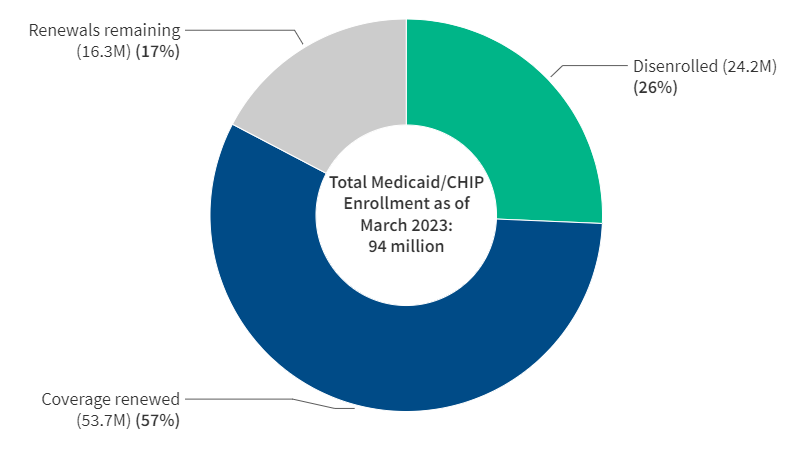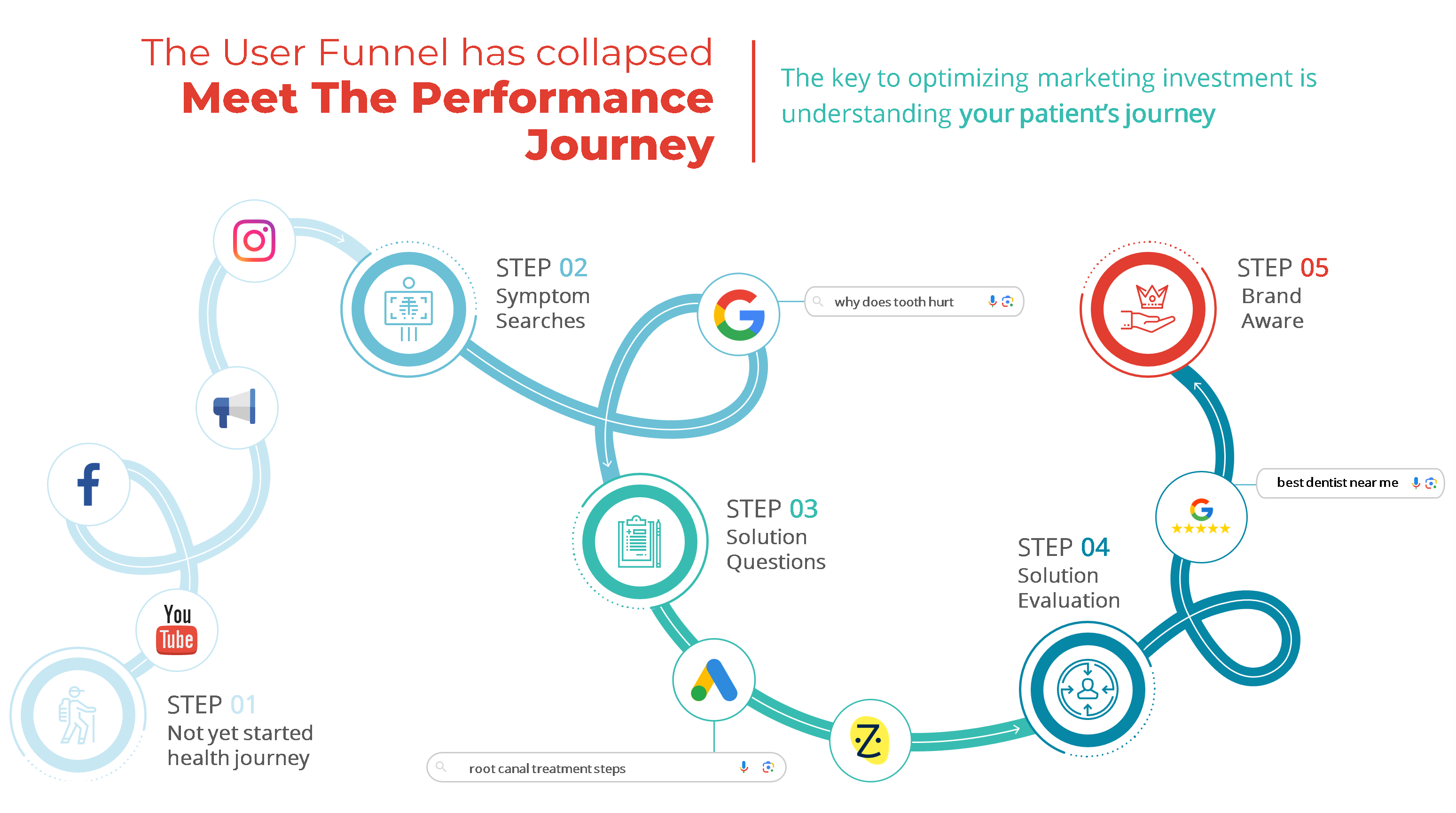We are just back from Dykema, the Definitive annual DSO Conference that has been running for over a decade. It’s basically the who’s who of Dental Service Organizations, not just all the biggest providers in the industry, but also every type of stakeholder in DSOs, from doctors to operators to vendors to investors. They even had the country’s best healthcare marketing firm (ahem)—and we enjoyed chatting with everyone who dropped by our booth.
Table of Contents
There were also a number of fantastic speakers and panels, addressing the biggest challenges facing dental practices today and offering some smart suggestions for where you might find opportunities to make gains. The current landscape is definitely challenging.
Dental Industry Trends and Challenges
Everyone at Dykema agreed that there are a few big challenges facing DSOs today:
New Patients Are Down
Thanks to inflation, more Americans are having to tighten their budgets and rein in spending on anything they don’t classify as an absolute necessity. And while dental care may be important, it’s often likely to be deferred when budgets get tight.
Exacerbating this is the fact that Medicaid coverage has been disappearing for many Americans. Tracking from KFF shows that since March 2023, over 23.8 million people have been disenrolled from Medicaid—including 45% of former Medicaid recipients here in Georgia, and over 2 million disenrolled in Texas alone. That’s roughly 25% of all people who had Medicaid coverage, now disenrolled in the past 14 months.

In short, that’s a whole lot of people who no longer have their dental bills covered, and are likely to put off that dental procedure for a year or three. And younger populations show lower demand for care in the first place. Gen Z and Millennials are less likely to be able to afford dental care, not only having a lower median income than other age groups but also being less likely than most age groups to have dental insurance coverage. Even those who can afford dental care often prioritize convenience and accessibility, which many practices don’t offer.
Costs Are Up
Supply costs shot up when COVID-19 hit the scene in 2020, and while some prices have come down since then, costs for supplies and materials still remain higher than pre-pandemic. Due to staffing shortages, offering higher wages is essential for practices that want to ensure they can maintain the capacity they need. This has put a squeeze on dental groups from both ends, as they face rising costs for staffing and supplies, but aren’t seeing any increase in Medicare reimbursement rates and can’t raise prices without losing patients who have limited discretionary income. Margins are thin, and DSOs more than ever need to look for ways to improve their marketing.
Interest Rates Are High
Money isn’t cheap anymore, which means it’s not so easy to decide to grow your business now and turn a profit later. The gold rush may be over, and we’ve seen a major slowdown in growth through mergers and acquisitions. Note that doesn’t mean that all growth has slowed, just that the industry has shifted towards more measured sustainable growth rather than an M&A blitz. For the past two years, the focus has been on same-store growth and growing organically through de novos, and we expect that will continue to be the trend for 2025.
What Industry Leaders Are Saying
The biggest takeaway here is that times may be tough, but DSOs still have plenty of ways to grow and should figure out how best to leverage those opportunities. No one knows that better than Pat Bauer, the CEO of Heartland Dental. During the “State of the Industry” session, he offered a simple reminder:
“You can’t use the economy as an excuse why you can’t grow. You have to figure out ways to grow.”
So, what’s the best advice for DSOs looking to grow today? Some of the leaders in the dental world shared their perspectives during the “CEO Panel: Challenges & Opportunities in Patient Acquisition & Retention,” and here’s what they had to say.
Meet Consumers Where They Are
Reveal Dental’s CEO, Houmam Ali, explained that to connect with the modern patient, you need a deep understanding of the modern patient journey, because old content and messages no longer work. You need to be present and relatable to today’s educated population where 90% of them have smartphones and can easily do online research. Video is a great way to differentiate yourself by nurturing the consumer along their decision-making journey. Just keep in mind that you need a strong USP and compelling creative if you want to use video to engage prospective patients and build trust.

Maximize Production at Every Practice.
Now that money isn’t cheap and it’s no longer easy to grow through acquisitions, you’ve got to make the most of the practices you already have. That means hiring more hygienists to support your dentists, so you can make use of your dentists more efficiently. ClariFi Health CEO Elliot Zibel suggested turning every available space into an operatory—you’re not getting new locations, so figure out what spaces you can convert into operatories and stick a specialist in there.
On the marketing side, you need to make sure your digital advertising is directing new patients to where you have the capacity. Otherwise, some practices will be starved for business, while others will be overbooked with an increasingly frustrated clientele. The key is aligning your marketing strategy with demand and capacity.
That’s certainly a topic I’ve written a lot about, and I’m about to write even more about it and give you some great tips on how to accomplish that at your DSO.
How To Maximize Your Marketing Impact
Margins are tight, costs are up, and leads are down. You need to make good use of every dollar in your marketing budget. But as you grow, advertising becomes more complex and nuanced because you can’t use a blanket approach across your whole platform.
What’s a DSO to do? Here are some of the top actionable suggestions for ensuring you get the most out of your investment and start super-charging your marketing.
1) Build an Integrated Measurement Platform
This is the #1 thing you need to do because if you want to put together marketing strategies that will work for your business, you need to know your numbers for show rates, cost per booking, LTV, etc. A good tech stack is the foundation of data-enabled marketing and gives you the right data signals to improve performance in an increasingly complex media buying landscape with sophisticated consumers.
Last-click attribution is last-decade tracking that leaves you marketing blind, without insight into what’s happening along the patient journey. A modern martech stack will help you build a multi-touch attribution framework that gives you a fuller picture of the patient journey so that you can nurture patients along the way. You need a CRM that can be integrated with an online booking platform like NexHealth and call tracking like Patient Prism. That’s what’s going to give you better data on the conversion actions and signals you can feed into your ad platforms.
With increasing demand for healthcare privacy and evolving HIPAA regulations, it’s a perfect time to update your martech stack. A well-integrated data platform will be compliant, provide you with better signals, and offer more transparency in reporting so you can see exactly the impact that marketing is having—essential in a high-competition environment where growth is the goal, but budgets are tight.
2) Align Capacity Goals with Media Strategy
Capacity is one of the most critical inputs for any advertising strategy, because you need to know which practices are struggling with production and which are already overbooked for three months. That’s vital info to have BEFORE you start allocating ad spend, not only for driving same-store growth but for making sure you’re maximizing your marketing ROI.
Never base marketing on “a general sense” of capacity.
Capacity is nuanced and you need specific data to get results. Talk with operations to get a deeper understanding of your capacity on every level: capacity by location, by doctor, hygienist, and by service line. Marketing and operations need to work together to develop a process that ensures the current capacity—which will fluctuate—is being integrated into the current ad strategy and budgeting.
3) Focus on the Types of Patients You Need to Grow
Marketing needs to be in conversation with the C-suite to understand exactly what is needed for growth – and to make sure the focus is in the right place.
Not all leads are the same. Stop treating all search intent and service-line conversions the same.
I’ve been beating this drum for a while because I’m still seeing some DSOs who are tracking “Cost Per Lead” as a single metric across everything as if a $100 cleaning lead had the same value as a $3000 orthodontics lead. Which one do you want more of?
You need a good martech stack so you know which clicks turned into cleaning and which turned into an implant procedure. Feeding that data back into the advertising algorithms enables them to find more users like that one.
Don’t be afraid to prioritize the leads you need with value-based bidding. If you want to get more valuable leads, you should take that value into account in your targeting and bidding and be willing to bid higher for qualified leads that will have a higher payoff on conversion.
A Reason To Smile
It may seem like a rough time to be a DSO, given the tight money situation on all ends. But what differentiates strong organizations from the rest is precisely their ability to continue growing through tough times.
I hope some of the strategies I’ve outlined above can help your dental group weather the storm and continue to bring in new patients, by using an integrated martech stack to align your marketing strategy with your capacity goals and the types of patients you need. We’ve helped many clients to do just that, by putting together a comprehensive patient acquisition strategy that leverages all of the above tactics and many more—and most importantly, always tailored to their specific situation. No two practices are exactly alike, so it’s essential to understand the relevant factors for YOUR practice so those inputs can help you drive new patient acquisition and get the most out of your marketing investment.

